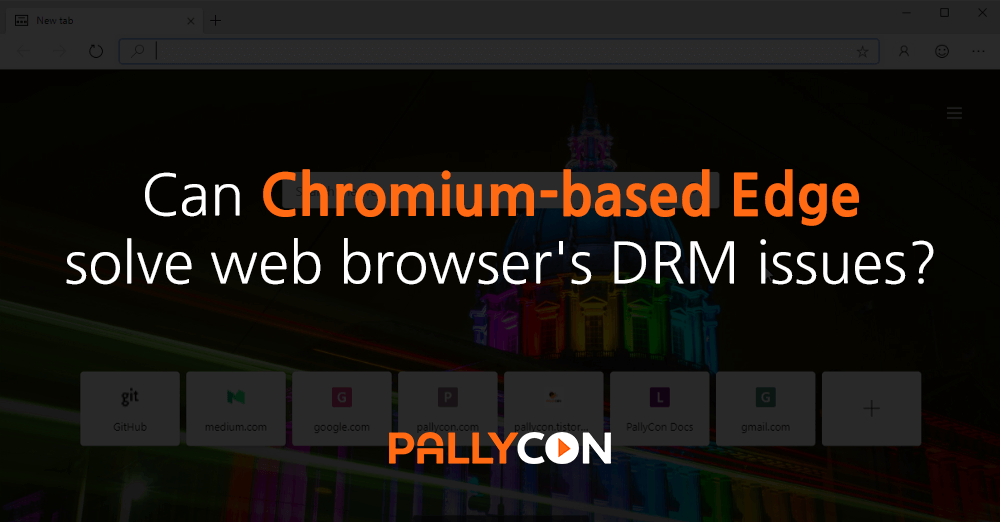
Can Chromium-based Edge solve web browser’s DRM issues?
A technical analysis of Microsoft’s new browser in terms of DRM and content protection.
Microsoft has announced that its new Chromium-based Edge will support not only Windows 10 but also Windows 7 and later versions (7, 8, and 8.1). (ref. #1) You can download a preview version of Edge browser for Mac OS and various Windows OS already on the Edge Insider website. (ref. #2)
Chromium is an open source web browser project. Chrome, as well as several web browsers such as Opera and Vivaldi are being developed based on chromium codes. (ref. #3)
The problems of web browser DRM support
OTT services such as Netflix are providing content through web browser using HTML5 based Multi-DRM technology to get more end users.
The screen recording issue of Chrome and FireFox browser
Chrome and Firefox are the most popular browsers that occupy 75% of the desktop and laptop browser share. (As of May 2019, Chrome has 66% and Firefox has 9.6% of the market. — ref. #4)
However, Widevine DRM embedded in these browsers has software level security (Widevine Level 3), which makes it easy to copy DRM video using various screen recording tools.
The low market share of Edge and Safari browser
Edge on Windows 10 and Safari on mac OS each support PlayReady or FairPlay DRM with hardware/OS level security. Therefore, these browsers prevent DRM video from being captured by screen recording tools. It is much safer from illegal leakage than playing DRM content on Chrome or FireFox.
In terms of content services, it is more secure to support only those browsers that prevent screen recording. But considering the low market share of those browsers (4.5% for Edge and 3.7% for Safari), they cannot help but support other browsers as well.
Then what about the Chromium-based Edge?
As a combination of the both browsers, can Chromium Edge solve the above problems of browser DRM? In conclusion, it cannot be a solution.
By testing preview version Edge, I found that the DRM support of Chromium Edge differs depending on each OS as below:
Chromium Edge for Windows 10
Chromium Edge installed in Windows 10 supports both PlayReady and Widevine DRM. This is the first major browser which has two DRMs embedded.
When PlayReady is used for playing DRM contents, it supports hardware level DRM and screen recording prevention function same as current Edge browser. If Widevine DRM is used instead, the video can be captured by screen recorder because of its software level security.
One thing to keep in mind when serving DRM content on the Windows 10 version of Chromium Edge is that you may need to modify your browser DRM detection logic.
Web pages that play multi-DRM content must detect the DRM and Encrypted Media Extension (EME) types to apply the DRM settings appropriate to the browser environment. If the logic is implemented to only check browser’s user agent info or the existence of Widevine, it may detect Chromium Edge as a Chrome browser. In that case, the DASH content will be played with Widevine DRM instead of PlayReady and you will miss the advantage of PlayReady such as hardware DRM and prevention of screen recording.
For more information on the Navigator.requestMediaKeySystemAccess API used for EME and DRM detection, please refer to the API documentation. (ref. #5)
Chromium Edge for older versions Windows (7, 8, 8.1) and mac OS
Chromium Edge installed in environments other than Windows 10 supports only Widevine DRM. Therefore, it is basically the same browser as Chrome in terms of DRM support and vulnerable to content leakage through recording tools.
I was hoping that PlayReady would be applied to Chromium Edge for older versions of Windows as well as Windows 10, but it was not.
Conclusion
The new Chromium-based Edge, which couples Chrome and Edge browsers, also has the same problems about DRM as current PC web browsers.
In order to respond to Edge’s low market share and Chrome’s screen recording issues, it is necessary to limit the quality of the content according to the browser, or to apply forensic watermarking in addition to DRM to track illegal leakage.
‘PallyCon Forensic Watermarking’ is a cloud-based forensic watermarking SaaS service provided by INKA Entworks, a content and application security technology company. It is integrated with ‘PallyCon Multi DRM’ service in a unified content workflow.
References
- #1 Windows Blog: https://blogs.windows.com/msedgedev/2019/06/19/introducing-microsoft-edge-preview-builds-for-windows-7-windows-8-and-windows-8-1/
- #2 Microsoft Edge Insider Channels: https://www.microsoftedgeinsider.com/en-us/download/
- #3 Wikipedia Chromium : https://en.wikipedia.org/wiki/Chromium_(web_browser)
- #4 Browser market share: https://netmarketshare.com/browser-market-share.aspx
- #5 Mozilla API guide: https://developer.mozilla.org/en-US/docs/Web/API/Navigator/requestMediaKeySystemAccess
Daniel is a DRM specialist and has been associated with this industry for over 10 years. Other than this, he is addicted to reading and writing.
